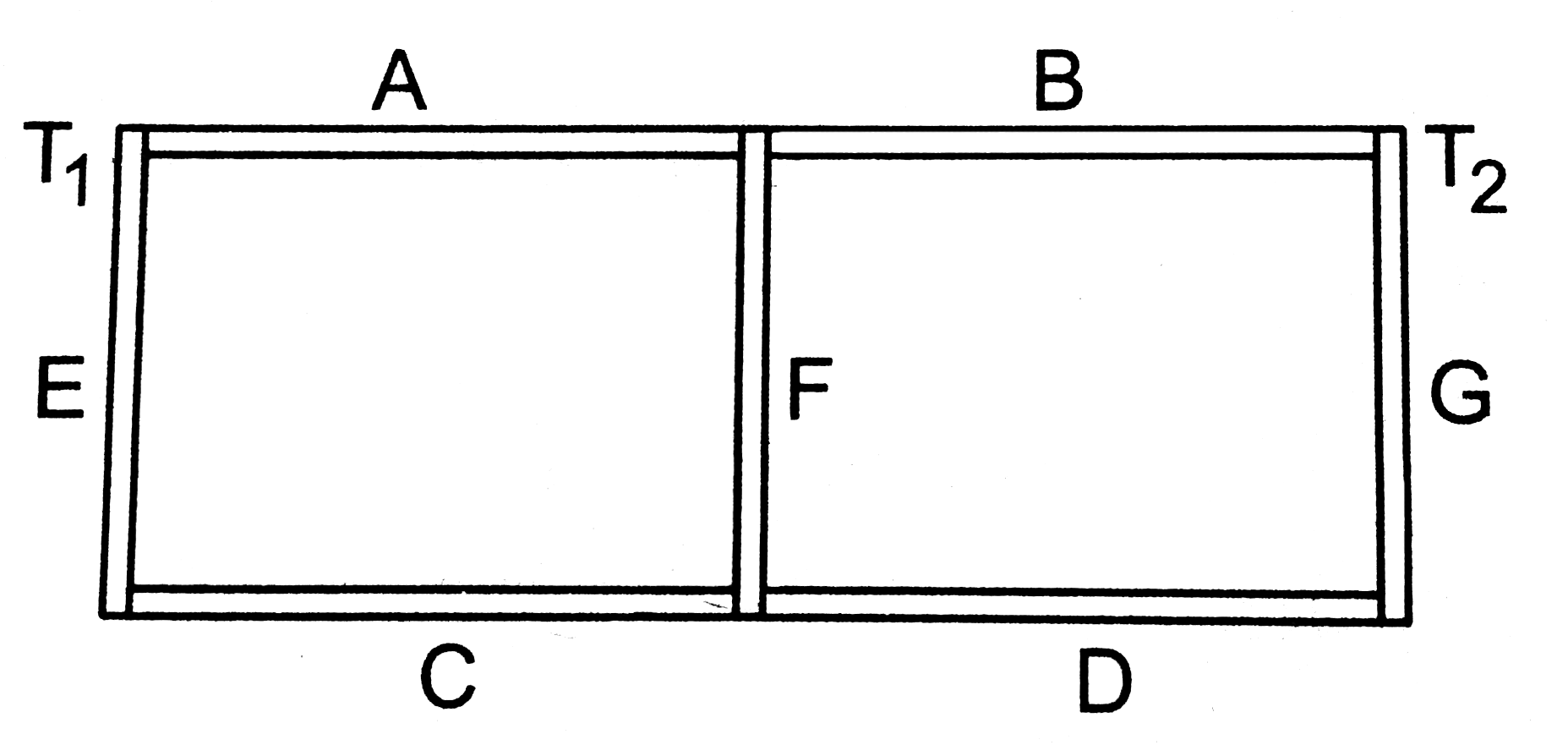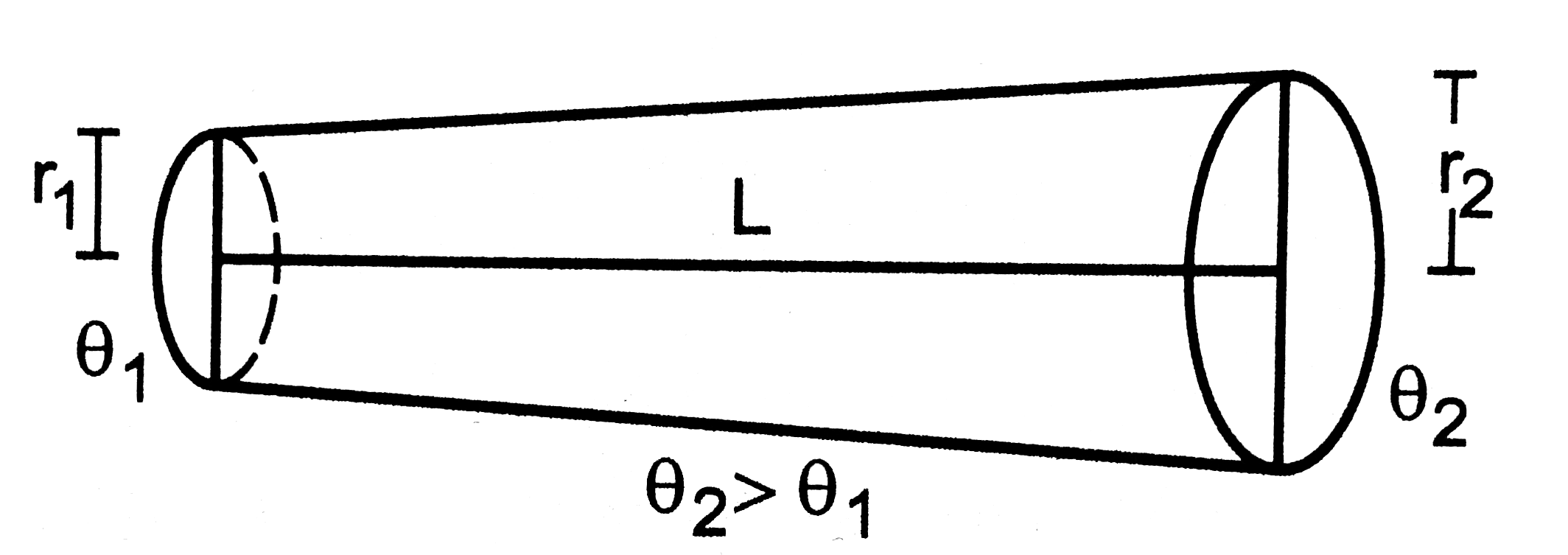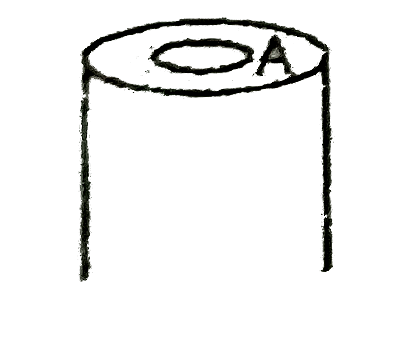Complete Solutions to Advancel Level Problems of chapter HEAT TRANSFER of Class 11 book with complete answers and questions
| Class 11 | PHYSICS |
| Chapter | HEAT TRANSFER |
| RESONANCE | Advancel Level Problems |
| Number Of Questions | 17 |
| Academic Year | 2023-24 |
Seven rods A, B, C, D, E, F and G are joined as shown in figure. All the rods have equal cross-sectional area A and length l. The thermal conductivities of the rods are `K_(A)=K_(C)=K_(0)`, `K_(B)=K_(D)=2K_(0)`, `K_(E)=3K_(0)`, `K_(F)=4K_(0)` and `K_(G)=5K_(0)` . The rod E is kept at a constant temperature `T_(1)` and the rod G is kept at a constant temperature `T_(2)``(T_(2)gtT_(1))` . (a) Show that the rod F has a uniform temperature `T=(T_(1)+2T_(2))//3` . (b) Find the rate of heat flowing from the source which maintains the temperature `T_(2)` .

View SolutionFind the rate of heat flow through a cross section of the rod shown in figure `(theta_(2)gttheta_(1))` . Thermal conductivity of the material of the rod is K.

View SolutionA solid aluminium sphere and a solid copper sphere of twice the radius are heated to the same temperature and are allowed to cool under identical surrounding temperatures. Assume that the emisssivity of both the spheres is the same. Find ratio of (a) the rate of heat loss from the aluminium sphere to the rate of heat loss from the copper sphere and (b) the rate of fall of temperature of the aluminium sphere to the rate of fall of temperature of copper sphere. The specific heat capacity of aluminium `=900Jkg^(-1)C^(-1)` . and that of copper `=390Jkg^(-1)C^(-1)` . The density of copper `=3.4` times the density of aluminium.
View SolutionA hot body placed in a surrounding of temperature `theta_(0)` obeys Newton's law of cooling `(d theta)/(dt)=-k(theta-theta_(0))` . Its temperature at `t=0` is `theta_(1)` the specific heat capacity of the body is `s` and its mass is `m`. Find
(a) the maximum heat that the body can lose and
(b) the time starting from `t=0` in which it will lose `90%` of this maximum heat.
View SolutionFind the total time elapsed for a hollow copper sphere of inner radius `3cm` outer radius `6cm`, density `rho = 9 xx 10^(3) kg//m^(3)`, specific heat `s = 4 xx 10^(3) J//kg K` and emissivity `e = 0.4` to cool from `727^(@)C` to `227^(@)C` when the surrounding temperature is `0.K` (for inner surface `e = 1` Stefan's constant `sigma = 5.6 xx 10^(-8) W//m^(2)K^(4))`
View SolutionA metal block of heat capacity `90J//.^(@)C` placed in a room at `25^(@)C` is heated electrically. The heater is switched off when the temperature reaches `35^(@)C`. The temperature of the block rises at the rate of `2^(@)C//s` just after the heater is switched on and falls at the rate of `0.2^(@)C//s` just after the heater is switched off. Assume Newton's law of cooling to hold (a) Find the power of the heater. (b) Find the power radiated by the block just after the heater is switched off. (c ) Find the power radiated by the block when the temperature of the block is `30^(@)C`. (d) Assuming that the power radiated at `30^(@)C` respresents the average value in the heating process, find the time for which the heater was kept on.
View SolutionA hollow tube has a length l, inner radius `R_(1)` and outer radius `R_(2)` . The material has a thermal conductivity K. Find the heat flowing through the walls of the tube if (a) the flat ends are maintained at temperature `T_(1)` and `T_(2)``(T_(2)gtT_(1))` (b) the inside of the tube is maintained at temperature `T_(1)` and the outside is maintained at `T_(2)` .
View SolutionCalculate thermal conductance for radial flow of an annular cylinder of length `l` and inner and outer radius `r_(1)` and `r_(2)`. Assume that thermal conductivity of the material is `K`

View SolutionCalculated thermal conductance for radial flow of a spherical sheel of inner and outer radius `r_(1)`and `r_(2)`. Assume that thermal conductivity of the material is `K`
View SolutionA metallic cylindrical vessel whose inner and outer radii are `r_1 and r_2` is filled with ice at `0^@C`. The mass of the ice in the cylinder is m. Circular portions of the cylinder is sealed with completely adiabatic walls. The vessel is kept in air. Temperature of the air is `50^@C`. How long will it take for the ice to melt completely. Thermal conductivity of the cylinder is K and its length is l. Latent heat of fusion of L.
View SolutionA uniform cylinder of length `L` and thermal conductivity `k` is placed on a metal plate of the same area `S` of mass `m` and infinite conductivity. The specific heat of the plate is `c`. The top of the cylinder is maintained at `T_(0)`. Find the time required for the temperature of the plate to rise from `T_(1)` to `T_(2)(T_(1) lt T_(2) lt T_(0))`.
View SolutionAssume that the total surface area of a human body is `1.6m^(2)` and that it radiates like an ideal radiator. Calculate the amount of energy radiates per second by the body if the body temperature is `37^(@)C` . Stefan constant `sigma` is `6.0xx10^(-8)Wm^(-2)K^(-4)` .
View SolutionThe surface of a household radiator has an emissivity of `0.55` and an area of `1.5 m^(2)`.
(a) At what rate is radiation emitted by the radiator when its temperature is `50^(@)C`?
(b) At what rate is the radiation absorbed by the radiator when the walls of the room are at `22^(@)C`? (c ) What is the net rate of radiation from the radiator? (stefan constant `sigma = 6 xx 10^(-8)W//m^(2)-K^(4))`
View SolutionA man, the surface area of whose skin is `2m^(2)` , is sitting in a room where air temperature is `20^(@)C` if his skin temperature is `28^(@)C` and emissivity of his skin equals 0.97, find the rate at which his body loses heat.
View SolutionAn electric heater is used in a room of total wall area `137m^(2)` to maintain a temperature of `20^(@)C` inside it, when the outside temperature is `-10^(@)C` .The walls have three different layers of materials. The innermost layer is of wood of thickness 2.5cm, the middle layer is of cement of thickness 1.0cm and the outermost layer is of brick of thickness 25.0cm. Find the power of the electric heater. Assume that there is no heat loss through the floor and the celling. The thermal conductivities of wood, cement and brick are `0.125Wm^(-1)C^(-1)` , `1.5Wm^(-1)C^(-1)` . and `1.0Wm^(-1)C^(-1)` respectively.
View SolutionA rod of length l with thermally insulated lateral surface consists of material whose heat conductivity coefficient varies with temperature as `k= a//T`, where a is a constant. The ends of the rod are kept at temperatures `T_1 and T_2`. Find the function T(x), where x is the distance from the end whose temperature is `T_1`.
View SolutionTwo block with heat capacities `C_(1)` and `C_(2)` are connected by a rod of length l, cross-sectional area A and heat conductivity K. Initial temperature difference between the two blocks I `T_(0)` . Assuming the entire system to be isolated from surroundings , heat capacity of the rod of be negligible. The temperature difference between the blocks as a function of time is.
View Solution
Advancel Level Problems questions and complete solutions for chapter HEAT TRANSFER of RESONANCE ENGLISH of Class 11